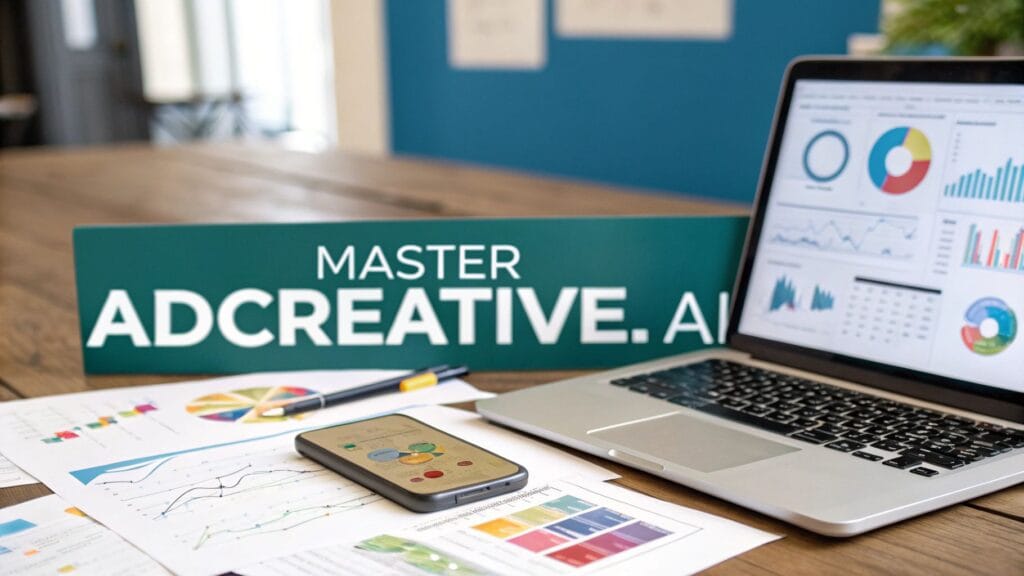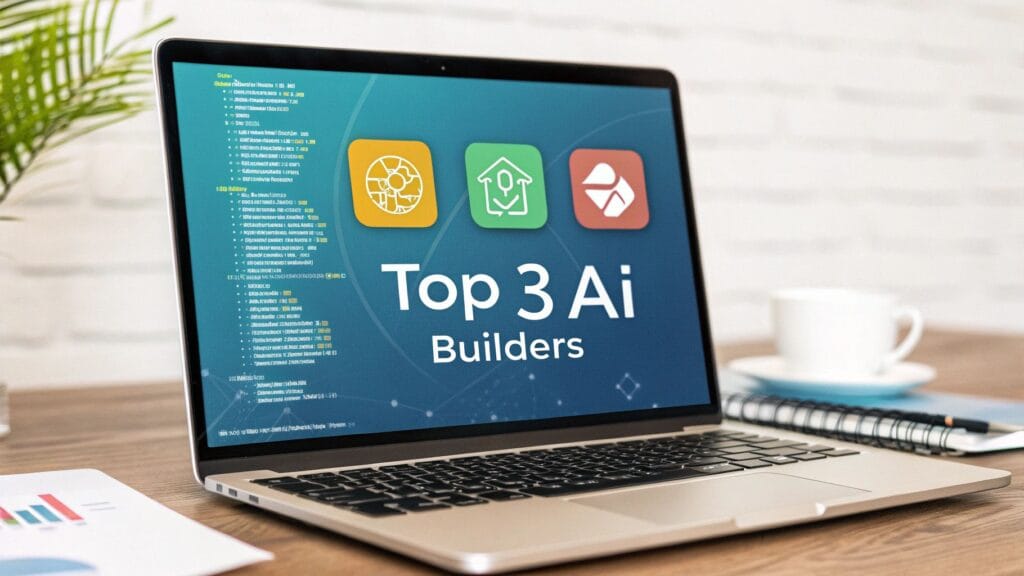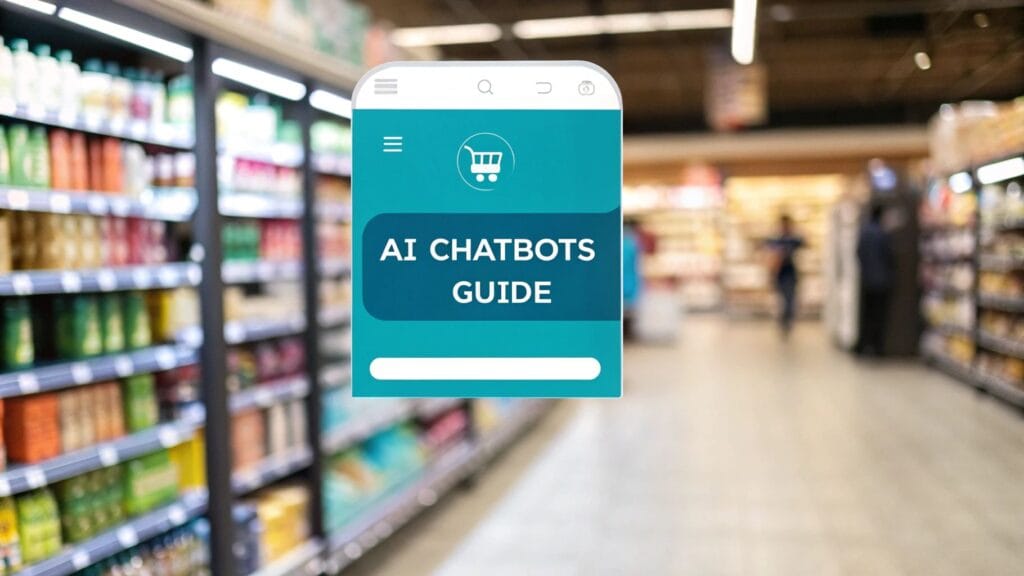Navigating the path to sustainable growth in the competitive Software-as-a-Service (SaaS) market requires more than just a great product. It demands a deliberate, multi-faceted approach to acquiring, retaining, and expanding your customer base. While the fundamentals of business remain, the SaaS model introduces unique challenges and opportunities, from managing churn to capitalizing on recurring revenue streams. The right combination of SaaS growth strategies can be the difference between stagnation and exponential scaling.
This guide moves beyond generic advice to provide a comprehensive and actionable roundup of proven tactics. We will dissect nine powerful strategies that successful SaaS companies use to fuel their expansion. Each section is designed to be a practical playbook, offering not just the "what" but the "how" and "why." You will find specific implementation steps, real-world examples from industry leaders, and the key metrics you need to track to measure your success accurately.
Whether you are a startup founder looking for your first hundred customers or a marketing manager at an established company aiming to accelerate momentum, this article will equip you with the insights needed to build a robust growth engine. We will explore everything from leveraging your product as the primary driver of acquisition with Product-Led Growth (PLG) to fostering a loyal user base through community building and maximizing customer lifetime value. Prepare to discover tangible strategies you can adapt and implement to drive meaningful, long-term growth for your SaaS business.
1. Product-Led Growth (PLG)
Product-Led Growth (PLG) is a go-to-market strategy that relies on the product itself as the primary driver of customer acquisition, conversion, and expansion. Instead of traditional, sales-led motions, PLG allows users to experience the product’s value firsthand through freemium tiers, free trials, or interactive demos before ever speaking to a salesperson. This hands-on approach is one of the most powerful SaaS growth strategies because it creates a direct, value-driven path to purchase.
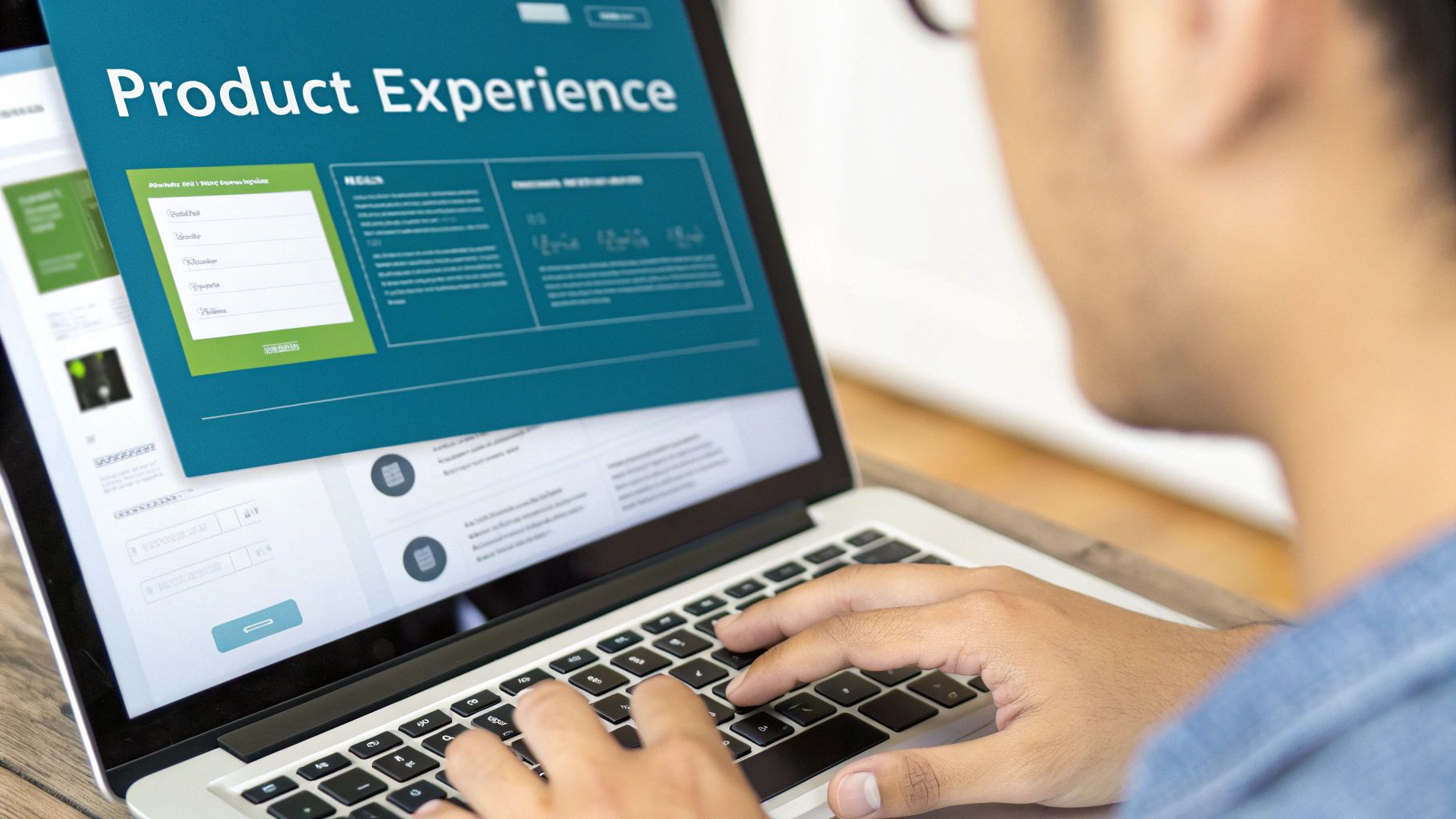
This model builds trust and demonstrates utility, letting the product do the selling. Companies like Slack and Calendly became household names by perfecting this approach. Slack’s viral loop is triggered when a user invites colleagues, while Calendly grows each time a user shares their scheduling link. In both cases, the core functionality promotes adoption organically.
How to Implement a PLG Strategy
Implementing PLG requires shifting focus from selling to helping users succeed. The goal is to minimize friction and maximize the user's time-to-value (TTV), the time it takes for a new user to realize your product's benefit.
- Focus on the "Aha!" Moment: Identify the key action that makes users understand your product's core value. Design your onboarding to guide every new user to this moment as quickly as possible.
- Build Viral Loops: Embed features that encourage sharing and collaboration directly into the user experience. This could be inviting team members, sharing a report, or co-editing a document.
- Implement Self-Service Onboarding: Create intuitive, guided onboarding flows with checklists, tooltips, and progress bars. This empowers users to learn independently and reduces reliance on support teams.
- Track Activation Metrics: Monitor user activation rates, feature adoption, and conversion funnels closely. Use this data to identify friction points and continuously optimize the user journey.
For a deeper dive into the principles of PLG, watch this insightful talk from Wes Bush, a leading authority on the topic.
2. Freemium Model
The Freemium Model is a popular pricing strategy where a company offers a basic, feature-limited version of its product for free, with no time limit. Users can access more advanced features, increased capacity, or premium support by upgrading to a paid subscription. This approach lowers the barrier to entry, allowing for widespread adoption and creating a large user base that can be nurtured toward paid plans. As one of the most effective SaaS growth strategies, freemium excels at generating leads and demonstrating product value upfront.
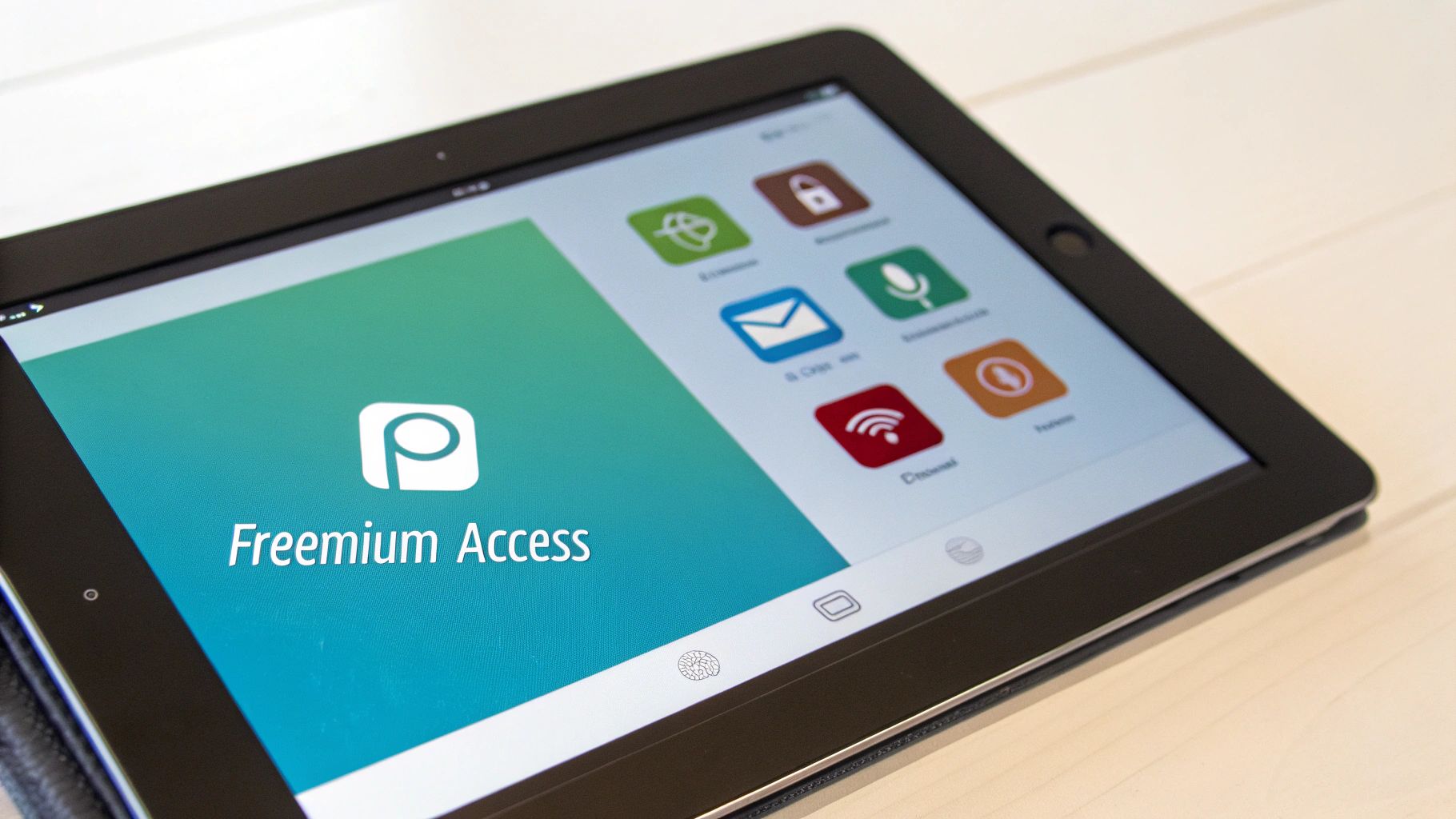
This model allows the product's core utility to attract and retain users. Companies like Mailchimp and Dropbox have scaled massively using this strategy. Mailchimp offers a generous free tier for new businesses with a small email list, creating a natural upgrade path as they grow. Similarly, Dropbox provides a base level of free storage, prompting users to pay for more space once they hit their limit. The key is that the free version is genuinely useful, not just a crippled demo.
How to Implement a Freemium Model
Successfully implementing a freemium model requires a delicate balance. The free tier must be valuable enough to attract and retain users, while the paid tiers must offer compelling reasons to upgrade. The goal is to make upgrading feel like a natural and necessary step in the user's journey.
- Define Clear Value-Based Limitations: Instead of random feature-gating, limit access based on usage that correlates with business growth. This could be the number of contacts (Mailchimp), storage space (Dropbox), or advanced features needed by power users (Canva).
- Create Obvious Upgrade Paths: Ensure users know exactly what they gain by upgrading. Use in-app prompts, comparison tables, and targeted email campaigns to highlight the benefits of paid features when a user hits a limitation.
- Ensure the Free Tier is Sustainable: Your free plan must be valuable enough to drive adoption but not so feature-rich that it cannibalizes paid conversions. Calculate the cost of serving free users and ensure your conversion rate to paid plans can support it.
- Monitor User Behavior and Conversion Funnels: Track which features free users engage with most and identify the triggers that lead to an upgrade. Use this data to refine your offering and optimize your upgrade prompts for maximum effectiveness.
3. Content Marketing & SEO
Content Marketing & SEO is a strategic, long-term approach focused on creating and distributing valuable, relevant, and consistent content to attract and retain a clearly defined audience. When combined with Search Engine Optimization (SEO), it becomes one of the most sustainable SaaS growth strategies, driving qualified organic traffic and building brand authority over time. Instead of interrupting potential customers with ads, this strategy pulls them in by answering their questions and solving their problems.

This inbound method builds trust and establishes your company as a thought leader in its niche. HubSpot, for example, built its empire on the back of a comprehensive marketing blog and educational resources that attract millions of visitors. Similarly, Ahrefs dominates SEO-related search results by providing unparalleled educational content about the very problems its tool solves, creating a powerful, self-sustaining growth engine.
How to Implement a Content & SEO Strategy
A successful content and SEO strategy requires a deep understanding of your ideal customer profile (ICP) and the challenges they face. The goal is to create a resource hub that meets their needs at every stage of their journey, from awareness to decision.
- Create Content Clusters: Build your content around core "pillar" topics relevant to your ICP. Create a comprehensive pillar page for each core topic, then support it with shorter "cluster" posts that cover specific subtopics and link back to the main pillar.
- Focus on Search Intent: Understand what users are looking for when they type a query. Create content that directly addresses their intent, whether it's informational (blog posts), navigational (pricing page), or transactional (demo request page).
- Repurpose Content Aggressively: Maximize the value of each content piece by repurposing it into different formats. A blog post can become a video, a series of social media updates, an infographic, or a webinar presentation.
- Build a Strong Internal Linking Structure: Use internal links to connect related pages on your site. This helps search engines understand your site's structure, distributes page authority, and guides users to relevant content, keeping them engaged longer.
For a more in-depth look at how these two disciplines work together, you can learn more about SEO content marketing on creavoid.com.
4. Referral Programs
Referral programs are a systematic way to incentivize existing, happy customers to bring in new users. This strategy turns your user base into a motivated, word-of-mouth marketing engine by offering rewards, such as credits or discounts, to both the referrer and the new customer. It’s one of the most cost-effective SaaS growth strategies because it leverages trust; a recommendation from a friend is far more powerful than a traditional advertisement.
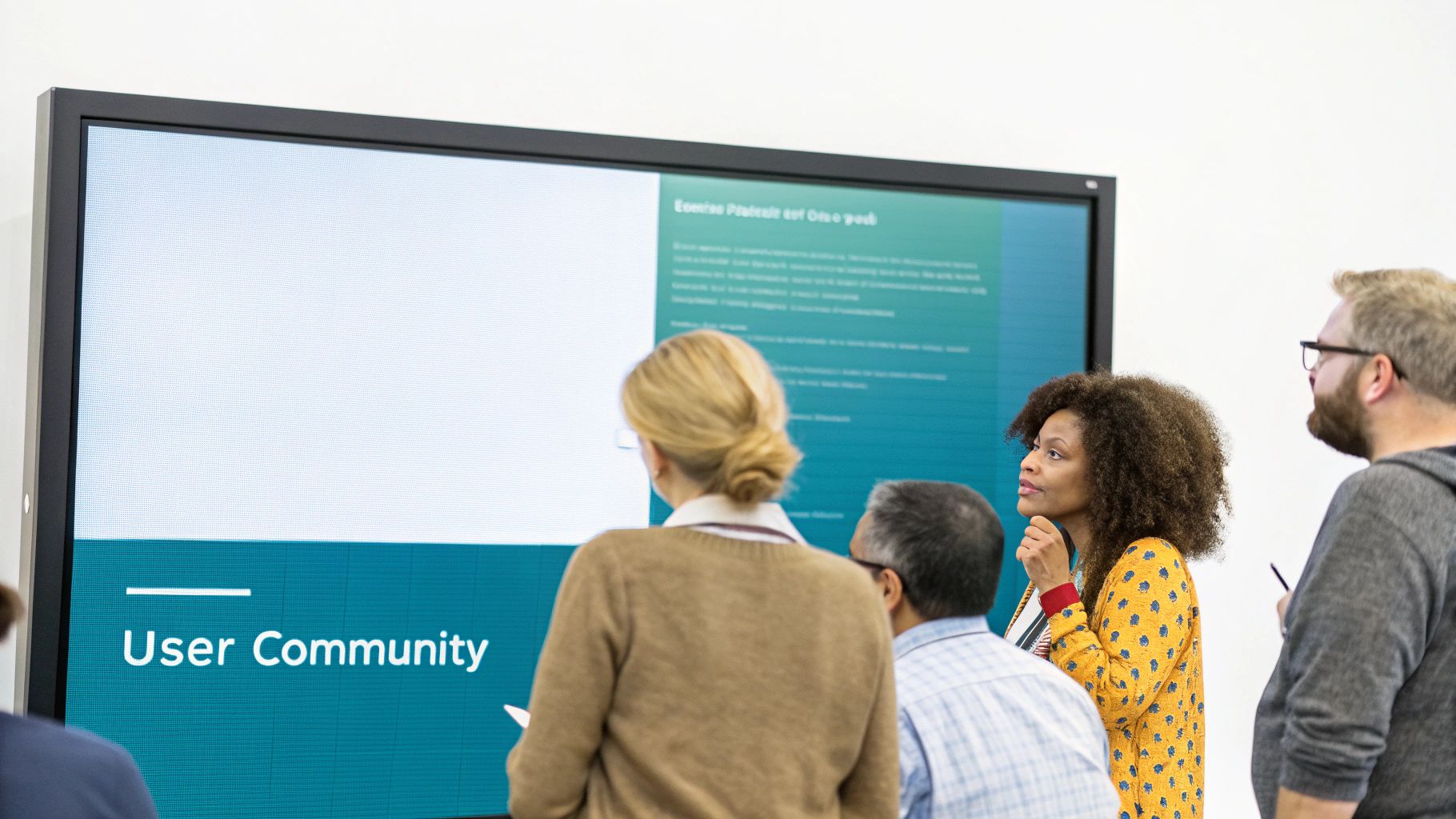
This approach creates a powerful, self-perpetuating growth loop. Dropbox famously used this model, offering free storage space to users who referred friends, a strategy that fueled its explosive early growth. Similarly, PayPal offered cash bonuses for referrals, while Typeform provides account credits, demonstrating that the reward should align with what your customers value most.
How to Implement a Referral Program
A successful referral program is built on simplicity and value. The goal is to make sharing effortless for your advocates and the reward compelling enough to motivate them.
- Make Sharing Frictionless: Integrate one-click sharing options directly within your app or customer dashboard. Provide pre-written messages and unique referral links that are easy to copy and share across email, social media, or messaging apps.
- Offer Valuable, Two-Sided Rewards: Motivate both parties by giving a reward to the referrer and a special offer to the new user. This could be service credits, feature unlocks, or account discounts that enhance their product experience.
- Time Your Ask Perfectly: Prompt users to refer others when their satisfaction is at its peak. This could be right after they’ve achieved a key milestone, received great customer support, or given you a high NPS score.
- Track Quality Over Quantity: Monitor the lifetime value (LTV) and churn rate of referred customers. This helps you understand which advocates bring in the most valuable users, allowing you to optimize your program for long-term growth, not just sign-ups.
5. Strategic Partnerships & Integrations
Strategic Partnerships and Integrations involve forming collaborative relationships with complementary businesses to create mutual value. This strategy expands your market reach and enhances your product's functionality by connecting it with other tools your customers already use. Instead of building every feature from scratch, you leverage existing ecosystems, turning potential competitors or adjacent software into powerful allies. This is one of the most effective SaaS growth strategies for tapping into established customer bases and adding immediate value.
This approach creates a win-win scenario where both partners benefit. Salesforce pioneered this with its AppExchange, creating a massive marketplace that makes its core CRM platform stickier. Similarly, Shopify’s extensive app ecosystem allows merchants to customize their stores endlessly, driving growth for both Shopify and its app partners. The core idea is to embed your product into your customers' existing workflows, making it indispensable.
How to Implement a Partnership & Integration Strategy
A successful partnership strategy is built on identifying and nurturing relationships that align with your customers' needs. The goal is to make your product more powerful and accessible by connecting it to the tools they love.
- Identify High-Value Partners: Start by analyzing your customer data. Which tools do they use most often alongside yours? Prioritize integrations with these high-demand platforms to deliver immediate value and align with your Ideal Customer Profile (ICP).
- Build a Robust Integration Framework: Create a well-documented API and provide clear guidelines for partners. A seamless development and onboarding experience encourages more companies to build integrations with your platform, expanding your ecosystem.
- Develop Co-Marketing Initiatives: A technical integration is only half the battle. Work with partners on joint webinars, blog posts, and marketing campaigns to promote the integration to both audiences, driving adoption and new leads.
- Measure Partnership ROI: Track key metrics like the number of leads generated from partner referrals, the adoption rate of new integrations, and the impact on customer retention. Use this data to optimize your partnership efforts and focus on the most fruitful relationships.
Developing a strong partnership and integration ecosystem is crucial for modern SaaS success. To see how these connections form the backbone of modern business technology, explore these insights on cloud platforms solutions from Creavoid.com.
6. Customer Success & Expansion Revenue
Customer Success & Expansion Revenue focuses on proactively ensuring customers achieve their desired outcomes while using your product. This goes beyond reactive support; it’s a strategic function designed to maximize customer value, which in turn drives retention and unlocks new revenue through upselling and cross-selling. As one of the most sustainable SaaS growth strategies, it treats customer relationships as an engine for growth, not just a cost center.
This strategy transforms the post-sale journey into a continuous growth loop. Companies like Gainsight and Zendesk have built their entire models around this philosophy, creating dedicated customer success teams to guide users, monitor health, and identify expansion opportunities. Similarly, usage-based platforms like Snowflake and Datadog pair proactive customer success management with their consumption models, ensuring clients not only stay but also increase their spending as they find more value.
How to Implement a Customer Success & Expansion Strategy
Implementing this strategy requires a shift from a reactive to a proactive mindset. The goal is to anticipate customer needs, mitigate churn risk, and systematically grow account value by aligning your success with theirs.
- Implement Customer Health Scoring: Develop a scoring system based on key metrics like product usage, feature adoption, support tickets, and NPS scores. This allows you to identify at-risk accounts and happy, high-potential accounts proactively.
- Establish Clear Success Milestones: Work with customers to define and track key milestones in their journey. Celebrating these achievements reinforces value and strengthens the partnership, creating a foundation for future growth.
- Segment Customers for Targeted Engagement: Not all customers need the same level of attention. Segment your user base by size, potential, or health score to create tailored communication cadences, from high-touch one-on-one reviews to low-touch automated check-ins.
- Use Data to Identify Expansion Opportunities: Analyze usage data to pinpoint customers who are hitting usage limits or could benefit from premium features. A customer success manager can then reach out with a relevant upsell or cross-sell offer that solves a real, observed need.
For more on building a world-class customer success engine, explore the content from Gainsight's CEO, Nick Mehta, a leading voice in the field.
7. Account-Based Marketing (ABM)
Account-Based Marketing (ABM) flips the traditional marketing funnel on its head. Instead of casting a wide net to capture as many leads as possible, ABM is a strategic B2B approach that concentrates sales and marketing resources on a defined set of high-value target accounts. This focus allows for highly personalized campaigns designed to resonate with the specific needs and pain points of key decision-makers within those organizations.
This hyper-targeted method is one of the most effective SaaS growth strategies for companies with a high average contract value (ACV). By treating each target account as a market of one, you can create deeply personalized experiences that cut through the noise. Companies like Snowflake and Terminus have mastered this by tailoring their entire go-to-market motion around specific enterprise accounts, leading to significant deals and long-term partnerships.
How to Implement an ABM Strategy
Effective ABM requires tight alignment between sales and marketing teams and a commitment to personalization at scale. The goal is to surround key stakeholders within a target account with relevant, valuable content across multiple channels, demonstrating a clear understanding of their business challenges.
- Align Sales and Marketing: Begin by creating a shared list of target accounts. Both teams must agree on the criteria for an ideal customer profile (ICP) and the specific companies that fit it. This alignment is the foundation of any successful ABM program.
- Create Account-Specific Value Propositions: Research each target account to understand its unique goals, challenges, and internal structure. Craft messaging and content that speaks directly to these points, showing exactly how your solution provides value for their specific situation.
- Use Intent Data: Leverage third-party intent data to identify which of your target accounts are actively researching solutions like yours. This allows you to time your outreach for maximum impact, engaging prospects when they are most receptive.
- Measure Account Engagement: Shift from traditional lead-based metrics (like MQLs) to account-based metrics. Track engagement levels across the entire account, including website visits, content downloads, and ad clicks from multiple contacts within the organization. For more insights into creating effective campaigns, you can explore some of the best online marketing strategies on creavoid.com.
8. Community Building
Community Building is the strategy of creating and nurturing an ecosystem where users, prospects, and industry enthusiasts can connect, share knowledge, and support one another. More than just a support forum, a thriving community becomes a powerful asset, fostering brand loyalty, generating user-generated content, and providing invaluable product feedback. This approach turns passive users into active advocates, making it one of the most sustainable SaaS growth strategies for long-term engagement and retention.
A strong community acts as a moat, differentiating your brand beyond features and pricing. Companies like Figma and Notion have excelled at this. Figma’s community is a hub where designers share plugins and files, while Notion’s user base creates and distributes countless templates, effectively demonstrating the product's versatility and driving adoption organically through peer-to-peer value exchange.
How to Implement a Community Building Strategy
Building a successful community requires a genuine commitment to providing value beyond your product. It’s about facilitating connections and empowering members to lead, not just follow.
- Start with Your Superusers: Identify and engage your most passionate users first. These champions can become your founding members and co-creators, helping set the tone and culture of the community.
- Provide Exclusive Value: Offer more than just product discussions. Share exclusive content, host expert AMAs (Ask Me Anything), provide early access to features, or create a space for professional networking.
- Hire Dedicated Community Managers: A community won't run itself. Invest in skilled community managers who can facilitate conversations, enforce guidelines, create engagement initiatives, and act as a bridge between the members and your company.
- Establish Clear Guidelines: Create and clearly communicate moderation policies and a code of conduct to ensure the space remains safe, respectful, and constructive for everyone.
- Engage Authentically: Encourage your internal team, from engineers to executives, to participate in the community. Authentic, transparent interactions build trust and show members they are truly being heard.
9. Viral Marketing & Network Effects
Viral Marketing leverages network effects, a phenomenon where a product becomes more valuable as more people use it. This strategy focuses on designing product features and marketing campaigns that naturally encourage users to share, invite others, or create content that spreads organically. Instead of paying for every new user, this approach turns your existing user base into a powerful acquisition engine, making it one of the most scalable and cost-effective SaaS growth strategies.
This model was pioneered by early platforms like Hotmail, which famously added a promotional signature to every outgoing email. Today, SaaS companies like Loom and Miro exemplify this strategy. Every time a user shares a Loom video recording or invites a colleague to collaborate on a Miro board, they are organically marketing the product. The core use of the product itself drives growth.
How to Implement a Viral Marketing Strategy
Implementing a viral strategy requires integrating sharing mechanisms directly into the core user workflow, making it a natural and valuable action rather than a tacked-on feature. The goal is to create a self-perpetuating loop of user growth.
- Embed Sharing into Core Workflows: Build sharing directly into the product’s primary function. Calendly does this perfectly, as sharing a scheduling link is essential to its use, exposing new people to the tool with every interaction.
- Create Share-Worthy Content: Encourage users to create content that they will naturally want to share publicly. This could be a beautifully designed report, a finished project, or a performance dashboard.
- Leverage Social Proof: Display usage statistics, popular templates, or testimonials to show new users that others are actively using and loving the product. This builds trust and encourages adoption.
- Optimize the Invitation Process: Make inviting others seamless and rewarding. Track key metrics like the viral coefficient (the number of new users generated by an existing user) to continuously refine your sharing mechanics.
For a classic read on how network effects create defensibility and drive growth, check out this foundational essay from a16z.
SaaS Growth Strategies Comparison Matrix
| Methodology | Implementation Complexity | Resource Requirements | Expected Outcomes | Ideal Use Cases | Key Advantages |
|---|---|---|---|---|---|
| Product-Led Growth (PLG) | High – demands strong product design and analytics | Moderate – product & analytics teams | Scalable growth, higher conversion, better product-market fit | SaaS with self-service products, viral potential | Lower acquisition cost, faster sales cycle, scalable |
| Freemium Model | Moderate – needs tier design and usage tracking | Moderate to high – infrastructure for free users | Large user base growth, low barrier to entry | Consumer apps, SaaS with clear upgrade paths | Builds user base, creates network effects, feedback loop |
| Content Marketing & SEO | Moderate to high – ongoing content creation | Moderate – content, SEO specialists | Long-term organic traffic, brand authority | B2B/B2C inbound marketing | Builds thought leadership, lowers acquisition cost |
| Referral Programs | Low to moderate – tracking & reward systems | Low to moderate – rewards and management | High-quality leads, viral growth potential | Businesses with existing satisfied users | Low acquisition cost, builds loyalty, leverages trust |
| Strategic Partnerships & Integrations | High – complex integrations and relationship management | Moderate – partner management teams | Access to new markets, increased product value | B2B, platform businesses | Shared costs, faster market reach, credibility boost |
| Customer Success & Expansion Revenue | High – dedicated teams and tracking systems | High – customer success managers | Reduced churn, increased lifetime value | SaaS, enterprise, subscription businesses | Drives retention, expansion revenue, customer advocacy |
| Account-Based Marketing (ABM) | High – personalized campaigns and tech stack | High – sales & marketing alignment | Higher conversion on high-value accounts | Enterprise B2B sales | Improved ROI, stronger relationships, shorter sales cycles |
| Community Building | High – continuous engagement and moderation | Moderate to high – community managers | Strong loyalty, organic growth via advocacy | Products with passionate user base | Builds advocacy, reduces support costs, network effects |
| Viral Marketing & Network Effects | Very high – product & marketing tightly integrated | Moderate – product & marketing teams | Exponential growth, low acquisition cost | Social apps, collaboration tools | Exponential growth, strong competitive moats |
Final Thoughts
Navigating the landscape of SaaS growth is a complex but exhilarating journey. We've explored a comprehensive arsenal of nine powerful SaaS growth strategies, moving from the user-centric pull of Product-Led Growth and viral marketing to the targeted precision of Account-Based Marketing. Each strategy represents not just a tactic, but a fundamental philosophy on how to attract, engage, and retain customers in a competitive digital ecosystem. The key takeaway is that there is no single "magic bullet" for sustainable growth. Instead, the most successful SaaS companies build a resilient, adaptable growth engine by strategically blending several of these approaches.
The path from a promising startup to a market leader is paved with strategic experimentation and a deep understanding of your ideal customer. Your initial growth might be sparked by a clever freemium model that lowers the barrier to entry, but long-term success will likely depend on nurturing those free users into advocates through exceptional customer success and a vibrant community. Similarly, a robust content marketing and SEO strategy can create a steady stream of inbound leads, which can then be accelerated through strategic partnerships and high-value integrations that embed your product into your customers' daily workflows.
Synthesizing Your Growth Strategy
The true power of these concepts is realized when they are integrated into a cohesive, multi-faceted plan. Think of these strategies not as isolated options on a menu, but as interconnected gears in a larger machine.
- Connect Your Flywheels: How can your Product-Led Growth model feed your Referral Program? When a user discovers a key feature on their own, that "aha!" moment is the perfect time to prompt them to share. How can your Community Building efforts provide insights for your Content Marketing? The questions asked and solutions shared within your community are a goldmine for relevant blog posts, tutorials, and case studies.
- Align Strategy with Stage: Early-stage startups might lean heavily on freemium models and content marketing to build initial awareness and user base with limited capital. A more mature SaaS business, on the other hand, might focus on expanding revenue from its existing customer base through dedicated Customer Success initiatives and launching sophisticated Account-Based Marketing campaigns to capture high-value enterprise clients.
- Measure, Iterate, and Evolve: None of these strategies are "set it and forget it." Success requires a relentless focus on data. Track your Customer Acquisition Cost (CAC), Lifetime Value (LTV), Net Revenue Retention (NRR), and viral coefficient (K-factor). Use these metrics to validate your hypotheses, understand what's working, and pivot away from what isn't. The SaaS market is dynamic; your growth strategy must be as well.
Your Path Forward
Ultimately, mastering these SaaS growth strategies is about more than just boosting metrics on a dashboard. It’s about building a durable business that delivers genuine value and creates a loyal following. It’s about transforming your product from a simple tool into an indispensable part of your customers' success story. The journey requires patience, creativity, and a willingness to learn from both your wins and your losses. By thoughtfully selecting, combining, and refining the strategies we've discussed, you can build a powerful and sustainable engine for growth that will propel your SaaS business to new heights.
Ready to put these strategies into action with powerful, data-driven content? creavoid offers an AI-powered platform to help you scale your content marketing and SEO efforts, generating high-quality articles and marketing copy designed to attract and convert your ideal customers. Visit creavoid to see how we can help you build the foundational content engine for your SaaS growth.

